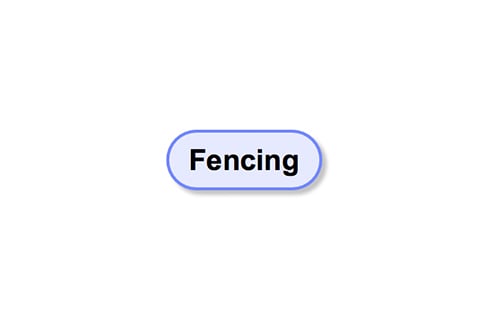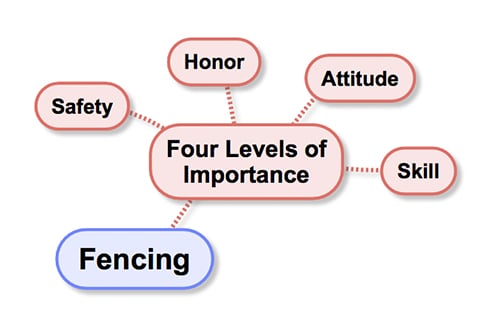A mind map is a simple hierarchical drawing or diagram. In other words, you organize your thoughts around a central idea. This technique is especially useful whenever you need to “dump your brain”, or develop an idea, a project, a problem, a solution, etc. By capturing what you have in your head, you make space for other thoughts and make a record of ideas and connections that you can refer back to later in your Fencing Journal.
It can be a little confusing at first, but Mind Maps can become quick ways to formulate thoughts and expand your vision of what a particular topic is made of. The objective of a mind map is always to clearly visualize your thoughts and ideas in an easy to digest format.
How to Make a Mind Map in Three Easy Steps
The three steps are:
- Pick a main topic
- Add branches of related ideas
- Add sub-branches for more relevant or detailed ideas
Let’s walk through each step and find out how easy it is to start making a Mind Map.
Step 1 : Pick a Main Topic
Take a blank sheet of paper, write down the topic you’ve been thinking about. Word it in a clear and concise manner. This is just your starting point that you’ll be exploring. I decided to be simple and focus on “Fencing.”

Step 2 : Add Branches of Related Ideas
With your main topic set, what is the first idea that comes to mind when you think of the subject for your mind map? Draw a line (straight or curved) from the central topic, and write down that idea. For me, the Four Levels of Importance popped up first.
It doesn’t matter what it is, just write it down. These branches will be larger categories that you can further break down in Step 3.

Step 3 : Add Sub-Branches for More Relevant Ideas
With your branch idea written down, what does that idea make you think of? What is related to it? List those things out next to it in the same way. From the Four Levels of Importance I listed out each individual principle: Safety, Honor, Attitude, Skill.
And that’s it! After three simple steps, we’ve created a basic Mind Map using the topic of Fencing. You can always add more to it later, but that’s good for now.

Repeat Step 2 and Step 3
You now have the choice to repeat steps 2 and 3 as many times as you need to flush out all of your ideas around the main topic that you chose.
I decided to make the Four Levels of Importance their own branches and break each down individually. You can see in my example below that each idea can branch off into other ideas. Some may only have a few branches while others have many. Add all the branches you want. This is meant to be a brain dump where you can jot down all your ideas. Don’t worry if it’s a little messy or if you should write it down. If it pops into your head, write it down.
After awhile, you can pause and look back on what you’ve come up with. Try to make additional connections or take any individual idea and expand it into a coherent sentence or paragraph. Try not to let yourself feel stupid or self-conscious. Just have fun with it! There is no wrong way to create a Mind Map.

Why Would You Want to Use a Mind Map
Mind Maps are incredibly useful to not only get all of your ideas out of your head, but they make a great record to come back to later. Each idea can be developed or studied to deepen your understanding and your Mind Map will be the guide on how they connect. You could spend an entire year trying to go through each principle and because you wrote them down, you’re not going to forget anything.
Plus, you can always go back and add more later. Your very first Mind Maps will look very different then the ones you make later on. Your own style and thought process will become evident and you’ll be able to see what is important to you.
Benefits I’ve Noticed When Using a Mind Map
I love Mind Maps. They really help me focus my thoughts and I have really benefited from using them and sharing them with others. Over time I’ve noticed specific benefits that I believe everyone should consider when they are starting out with Mind Maps. Those benefits are:
- They keep me focused
- They give me ideas to work on when I hit a slump or plateau
- They are great conversation starters with my apprentices and other fencers
- They are a record of my thought process and my growth as a fencer
- They deepen my understanding and make my thoughts more concrete
Create Your Own
I would never hesitate to encourage someone to make a Mind Map. I’ve experienced the benefits myself and I know that they can benefit anyone. I would challenge you to try making your own Mind Map using the three easy steps above.
In tomorrow’s practice, we’ll be making them together and seeing what we all come up with, so since you read this week’s Woodland Watch you’ll be more prepared than those who didn’t. For that I congratulate you! Here, have a cookie!


I love mind mapping! It is a great way to get stuff out of your head to see what youre thinking about. This helps me to see what is important and make plans and goals. I love making connections and exploring thoughts in this visual way.
I have several mind maps for fencing. And they have been very helpful, in many ways, over time.